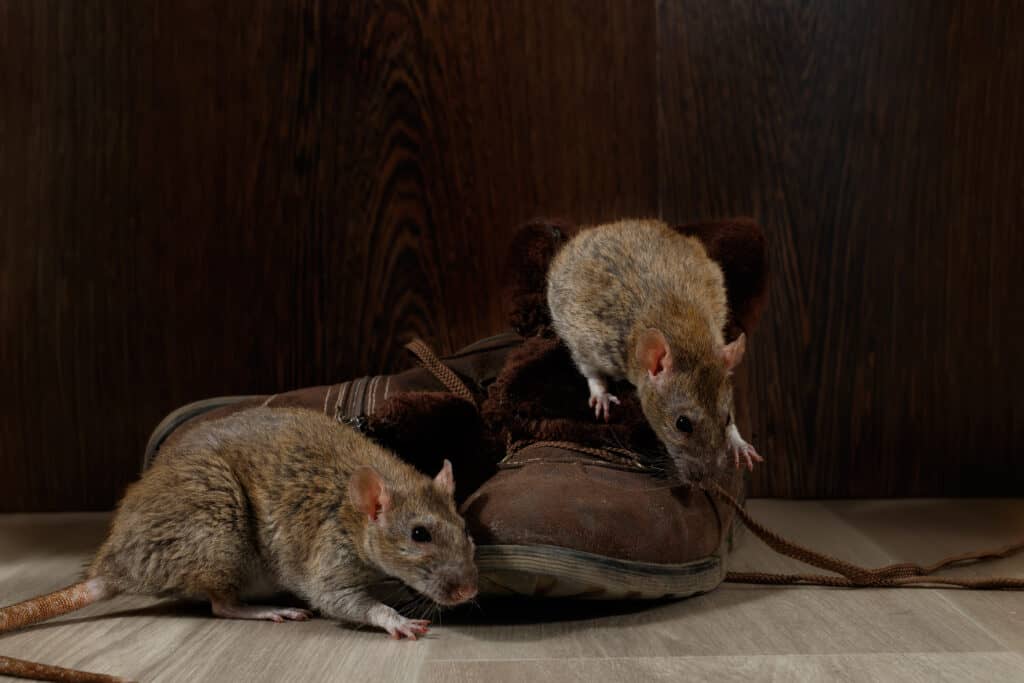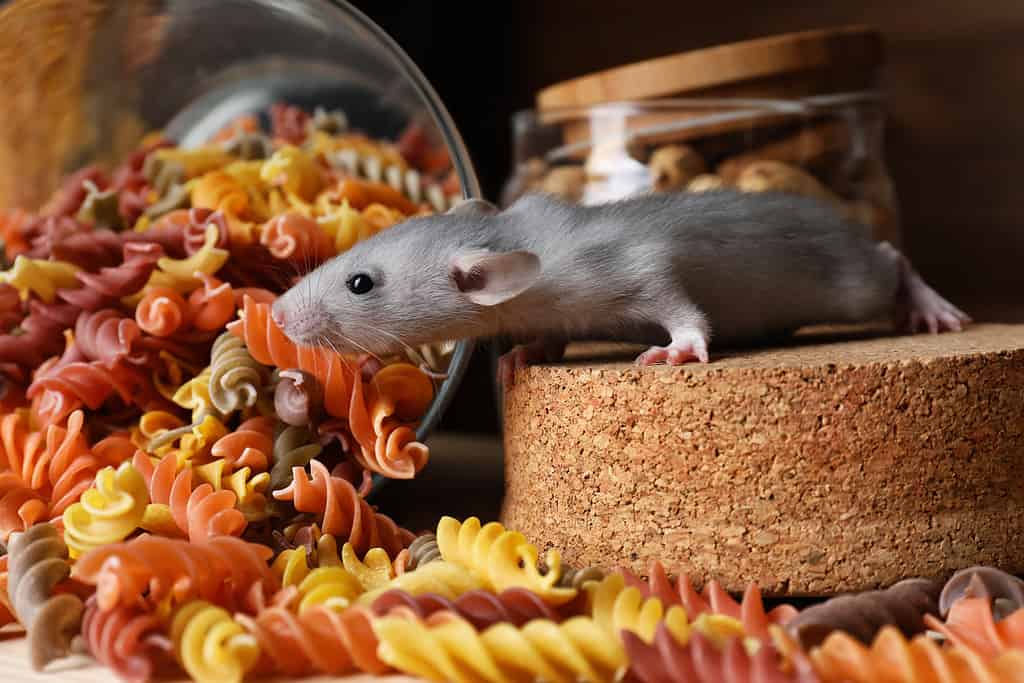Imagine being in bed at night, almost asleep, and hearing scratching and squeaking noises. When you turn the light on, you can’t detect anything that could be making those sounds. That’s when it dawns on you. There are rats in the walls and the attic, running across your ceiling. It’s nightmare fuel, and you need to get rid of the critters fast. There’s only one question: how? Let’s take a look at some of the ways you can evict the rodents from your house.
Which Rats Typically Infest Homes?

The most common rat in North America, Norway rats are native to China.
©torook/Shutterstock.com
Norway rats (Rattus norvegicus) are common home invaders, often entering houses in the fall to search for food and escape the cold. These rats can gnaw through siding and pipes, potentially causing thousands of dollars worth of property damage. Norway rats hide inside the walls, crawlspaces, or lower areas of the home.
True to their name, roof rats (Rattus rattus) tend to nest in attics. These rats are also known as ship rats because of their presence on Colonial-era large boats. They enter through spaces in the upper areas of houses. Often, roof rats will gain access via tree limbs near or hanging over homes. They construct their nests from leaves and twigs. Female roof rats can spawn up to five litters per year.
Why Are Rats Bad?

Rats are commonly blamed for the spread of the bubonic plague throughout Europe in the 1300s.
©BiZhaMox/iStock via Getty Images
Some people think rats are cute, but that’s no reason to let them run rampant inside your four walls. Rats are hungry creatures that love to chew. Rats can bite through wiring in your home. They often gnaw their way into cereal boxes or pet food bags, increasing the chances of contaminating those food sources with fecal matter. In a worst-case scenario, rats will bite humans and transmit diseases through the wounds. Rat-bite fever, a bacterial infection that can be fatal if left untreated, is a common illness spread via rat bite.
What Are the Common Signs of a Rat Infestation?

Rats leave behind waste products which can make food unsafe to eat.
©Liudmila Chernetska/iStock via Getty Images
You may notice rat droppings before any other indication that rats have taken up residence in your home. Check in dark places such as corners, inside drawers or cabinets, or behind household appliances. When rats chew, their large teeth leave behind gnaw marks. Those could be on anything from pieces of produce left on the counter to furniture and anything in between. Rats also chew through air ducts, plastic, and insulation.
Not only will you hear scratching, usually at night, but you may also discover piles of shredded material like paper or insulation. Those could be signs that rats are constructing nests and possibly breeding. Rats have a distinct foul odor and oily fur. You may notice a bad smell or greasy smudges on the walls.
How Can I Discourage Rats From Invading My Home?

Rats can fit their bodies through a hole the size of a quarter.
©Nigel Harris/iStock via Getty Images
Blocking entrances on the outside of your house is a good place to start. Fill holes or gaps with steel wool and seal them in place with caulk. If necessary, use fitted pieces of metal screen around pipes and downspouts. Make sure the area surrounding your home is clean. Keep bushes and weeds trimmed back. Remove any tree branches hanging over your roof. Don’t leave garbage lying about outside. Places where food could be, such as grilling areas or trash cans, should be kept at least 100 feet away from your home.
Inside, keep all your food safely put away. Comestibles should be placed in sturdy plastic bags or lidded containers. Take the trash out often. Pet food should also be put away, with food and water bowls brought inside at night.
Are There Humane Methods to Get Rid of Rats?

Essential oils, such as peppermint and citronella, may repel rodents.
©rawf8/Shutterstock.com
Rats are sensitive to smell and will shy away from scents they find unpleasant. Perhaps the most widely known natural deterrent is peppermint oil. Although humans find the scent attractive, rats can’t stand the stuff. Spray a mixture of one cup of water or rubbing alcohol and two teaspoons of peppermint oil where rats are known to enter or exit walls. That strong peppermint smell will drive rats away. You can also soak cotton balls in peppermint oil and place them in the rats’ pathway. However, the scent will quickly evaporate, so they must be replaced every two weeks. Peppermint also masks food smells, keeping rats at a distance from food storage and preparation areas.
Citronella oil not only keeps away pesky mosquitoes, but its lemony fragrance prevents rats from sniffing out food. Place five drops of citronella oil into eight ounces of water in a spray bottle. Use the spray in areas where rats are known to be present.
Ammonia, a common ingredient in household cleaners, can also be used as a repellent. Rats will avoid the powerful scent of ammonia because it reminds them of urine. That smell is a trigger for rats because they believe it indicates the presence of an enemy. Always dilute ammonia in water before setting it near any areas of rat activity. Ammonia reportedly can damage a rat’s lungs, potentially leading to death.
Get A Cat

Cats that are adept at hunting rodents are known as “mousers.”
©RAUL RODRIGUEZ/iStock via Getty Images
For decades, cartoons have told us that cats and rats are natural enemies. That may be true in some cases, but there’s a chance your cat may not be a good rat killer. However, the mere presence of a cat in your home can deter rats. Because of their sensitive sense of smell, rats can smell the unique odor of cats. When they rub up against things, even their owners, cats are marking their territory. Rats recognize that scent and stay away.
Used kitty litter also works as a rat repellent. According to scientific research, one of the proteins found within cat urine triggers a primal fear response in the brains of rats. Sprinkle the used litter where you suspect the rats are gaining access to your walls. When rats smell one of their natural predators, they’ll do their best to avoid contact.
While these natural repellents may be effective at driving some of the rats away, none of them are guaranteed to solve your rat problem forever. For that, you’ll have to resort to more permanent solutions.
Snap Traps

William C. Hooker patented the design for the snap trap in 1894.
©Image Source/DigitalVision via Getty Images
Spring-loaded traps are frequently employed to rid a home of rats. Snap traps consist of a metal bar, held in place by a small hook, that activates when the rat steps on a pressure plate. That pressure plate is baited with a small bit of food that rats like. Peanut butter is an excellent choice for bait. When the rat eats the bait, the sensitive pressure plate gives way and releases the hook. Ideally, the bar snaps down on the rat’s neck, killing it quickly and painlessly.
Rats are wary around new objects in their environment. At first, try baiting the traps without setting them. This allows the rats to get used to the traps and begin eating the food. When you notice the bait missing from the trap or tell-tale gnaw marks, it’s time to begin loading and setting the traps. Move the traps around to different areas where rats are active every couple of days. Keep the traps away from children and pets.
Poison Traps

Some rat poisons work by blocking the synthesis of vitamin K, which assists in blood clotting.
©dokurose/Shutterstock.com
Rat poison is often used to halt home infestations. Poison, along with a little bait food, is placed inside a container called a bait station. Attracted to the scent, rats enter the bait station and consume the poison. Sometimes, the rats will take the poison back to their nest, spreading it around the population. Although the toxin does not cause instant death, rats will die within one to two days after ingesting the poison.
Keeping rat poison around the house can be dangerous. Rats will move to difficult-to-reach places to die, meaning there will be dead rats in your walls and your attic. That smell could attract more pests into your home. Not only does it pose a threat to pets and children, rat poison kept in an outdoor bait station can be consumed by local wildlife. Rat poison will definitely kill rats, but collateral damage is possible. Take all those possibilities into consideration before deciding on using rat poison.
Electronic Traps

Electronic traps lure the rat inside, allowing homeowners to empty the container without touching the rat.
©Alan Levine from Strawberry, United States / CC BY 2.0 – Original / License
A high-tech method of rodent control, battery-powered electronic traps use electricity to kill rats. Completely enclosed, sophisticated sensors distinguish the presence of a rat entering the trap and approaching the bait. When the rat steps on pressure-sensitive plates, the trap delivers a high-voltage shock strong enough to electrocute the rat. Some electronic traps will emit a green warning light after a rat has been caught.
Because they are self-contained, electronic rat traps are safer to use around kids and pets than poison bait stations or snap traps. Place the traps in areas where rats congregate for maximum effectiveness. Check the traps daily and dispose of the remains outside.
Bring in the Professionals

On average, the cost of hiring a rat exterminator starts at around $200.
©LightField Studios/Shutterstock.com
If do-it-yourself solutions don’t do the trick, then it may be time to call an extermination company. How exterminators go about removing the rats from your home depends on the severity of the infestation. Pest control professionals will perform a preliminary inspection to ascertain the seriousness of your rat problem. After that, a plan of action will be created.
Exterminators may use a combination of traps and poison chemicals to destroy the rat population in your home. Various factors, such as the size of the home and how great the infestation is, will affect how long it will take to get rid of the rats and how much it will cost. In some cases, live traps can be used in order to relocate the rats without killing them. If a heavy infestation is detected, the home may need to be tented off and fumigated.
The photo featured at the top of this post is © Carlos Aranguiz/Shutterstock.com
Thank you for reading! Have some feedback for us? Contact the AZ Animals editorial team.







